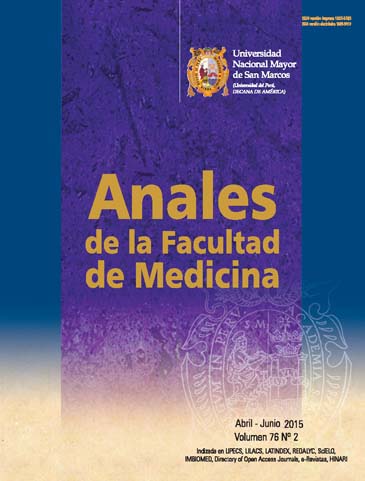In vivo evaluation of Aloysia triphylla britton (lemon verbena) essential oil toxicity and citral anti-Trypanosma cruzi activity.
DOI:
https://doi.org/10.15381/anales.v76i2.11137Keywords:
Trypanosoma cruzi, essential oil, cedron, toxicity, citral.Abstract
Introduction: There is limited research on neglected diseases. Medicinal plants are potential sources of antimicrobial compounds. Objectives: To determine the toxicity of Aloysia triphylla essential oil and citral activity against Trypanosoma cruzi in mice. Design: Experimental study in vivo, preclinical. Setting: Faculty of Medicine, Universidad Nacional Mayor de San Marcos, Lima, Peru. Biological material: Albino mice. Main outcome measures: Signs of toxicity and mortality and parasitemia. Interventions: Acute oral toxicity at single dose was evaluated in albino rats. For trypanocidal activity mice were assigned to the following groups: untreated infected (G1), infected and treated with citral at doses 50, 150 and 300 mg/kg/day (G2, G3 and G4 respectively), infected and treated with benznidazole 100 mg/kg (G5), and uninfected and untreated (G6). Parasitemia was determined individually every 2 days by direct microscopy. In days 14, 21 and 28 post infection five mice from each group were sacrificed and their hearts processed for histopathology. Results: The limit dose of 2 000 mg/kg did not cause signs or symptoms of toxicity and macro and microscopic anatomopathology did not show alterations in the organs studied. Parasitemia was significantly reduced at dose of 300 mg/kg at days 16, 18, and 20 post infection (p <0.05); the number of amastigote nests and inflammatory infiltrates in heart were reduced on day 28 by 67.7% and 51.7% respectively with 300 mg/kg. Conclusions: Aloysia triphylla essential oil is qualified as nontoxic and citral at 300 mg/kg dose had activity against Trypanosoma cruzi in mice.Downloads
Published
2015-06-15
Issue
Section
Artículo Original
License
Copyright (c) 2015 Juan Rojas Armas, Olga Palacios Agüero, José Manuel Ortiz Sánchez, Leavit López de la Peña

This work is licensed under a Creative Commons Attribution-NonCommercial-ShareAlike 4.0 International License.
Those authors who have publications with this magazine accept the following terms:
- Authors will retain their copyrights and guarantee the journal the right of first publication of their work, which will be simultaneously subject to Creative Commons Attribution License that allows third parties to share the work as long as its author and its first publication this magazine are indicated.
- Authors may adopt other non-exclusive licensing agreements for the distribution of the version of the published work (eg, deposit it in an institutional electronic file or publish it in a monographic volume) provided that the initial publication in this magazine is indicated.
- Authors are allowed and recommended to disseminate their work over the Internet (eg: in institutional telematic archives or on their website) before and during the submission process, which It can produce interesting exchanges and increase quotes from the published work. (See El efecto del acceso abierto ).
How to Cite
1.
Rojas Armas J, Palacios Agüero O, Ortiz Sánchez JM, López de la Peña L. In vivo evaluation of Aloysia triphylla britton (lemon verbena) essential oil toxicity and citral anti-Trypanosma cruzi activity. An Fac med [Internet]. 2015 Jun. 15 [cited 2025 Jun. 6];76(2):129-34. Available from: https://revistasinvestigacion.unmsm.edu.pe/index.php/anales/article/view/11137



